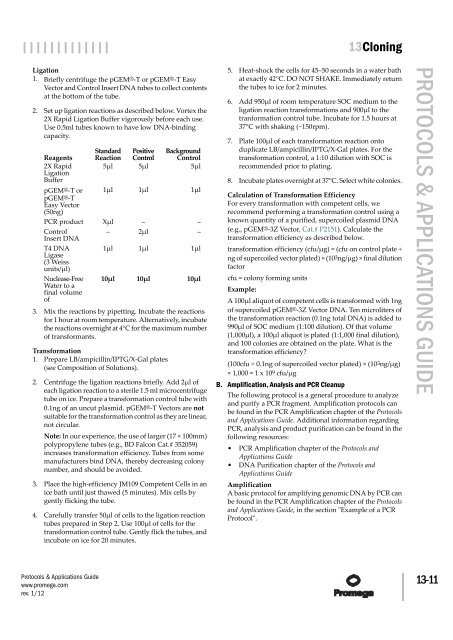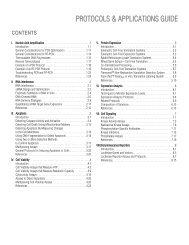Cloning Protocols and Applications Guide-A4 format - Promega
Cloning Protocols and Applications Guide-A4 format - Promega
Cloning Protocols and Applications Guide-A4 format - Promega
You also want an ePaper? Increase the reach of your titles
YUMPU automatically turns print PDFs into web optimized ePapers that Google loves.
||||||||||||| 13<strong>Cloning</strong><br />
Ligation<br />
1. Briefly centrifuge the pGEM®-T or pGEM®-T Easy<br />
Vector <strong>and</strong> Control Insert DNA tubes to collect contents<br />
at the bottom of the tube.<br />
2. Set up ligation reactions as described below. Vortex the<br />
2X Rapid Ligation Buffer vigorously before each use.<br />
Use 0.5ml tubes known to have low DNA-binding<br />
capacity.<br />
Reagents<br />
2X Rapid<br />
Ligation<br />
Buffer<br />
pGEM®-T or<br />
pGEM®-T<br />
Easy Vector<br />
(50ng)<br />
PCR product<br />
Control<br />
Insert DNA<br />
T4 DNA<br />
Ligase<br />
(3 Weiss<br />
units/µl)<br />
Nuclease-Free<br />
Water to a<br />
final volume<br />
of<br />
St<strong>and</strong>ard<br />
Reaction<br />
5µl<br />
1µl<br />
Xµl<br />
–<br />
1µl<br />
10µl<br />
Positive<br />
Control<br />
5µl<br />
1µl<br />
–<br />
2µl<br />
1µl<br />
10µl<br />
Background<br />
Control<br />
5µl<br />
1µl<br />
–<br />
–<br />
1µl<br />
10µl<br />
3. Mix the reactions by pipetting. Incubate the reactions<br />
for 1 hour at room temperature. Alternatively, incubate<br />
the reactions overnight at 4°C for the maximum number<br />
of transformants.<br />
Trans<strong>format</strong>ion<br />
1. Prepare LB/ampicillin/IPTG/X-Gal plates<br />
(see Composition of Solutions).<br />
2. Centrifuge the ligation reactions briefly. Add 2µl of<br />
each ligation reaction to a sterile 1.5 ml microcentrifuge<br />
tube on ice. Prepare a trans<strong>format</strong>ion control tube with<br />
0.1ng of an uncut plasmid. pGEM®-T Vectors are not<br />
suitable for the trans<strong>format</strong>ion control as they are linear,<br />
not circular.<br />
Note: In our experience, the use of larger (17 × 100mm)<br />
polypropylene tubes (e.g., BD Falcon Cat.# 352059)<br />
increases trans<strong>format</strong>ion efficiency. Tubes from some<br />
manufacturers bind DNA, thereby decreasing colony<br />
number, <strong>and</strong> should be avoided.<br />
3. Place the high-efficiency JM109 Competent Cells in an<br />
ice bath until just thawed (5 minutes). Mix cells by<br />
gently flicking the tube.<br />
4. Carefully transfer 50µl of cells to the ligation reaction<br />
tubes prepared in Step 2. Use 100µl of cells for the<br />
trans<strong>format</strong>ion control tube. Gently flick the tubes, <strong>and</strong><br />
incubate on ice for 20 minutes.<br />
<strong>Protocols</strong> & <strong>Applications</strong> <strong>Guide</strong><br />
www.promega.com<br />
rev. 1/12<br />
5. Heat-shock the cells for 45–50 seconds in a water bath<br />
at exactly 42°C. DO NOT SHAKE. Immediately return<br />
the tubes to ice for 2 minutes.<br />
6. Add 950µl of room temperature SOC medium to the<br />
ligation reaction trans<strong>format</strong>ions <strong>and</strong> 900µl to the<br />
tran<strong>format</strong>ion control tube. Incubate for 1.5 hours at<br />
37°C with shaking (~150rpm).<br />
7. Plate 100µl of each trans<strong>format</strong>ion reaction onto<br />
duplicate LB/ampicillin/IPTG/X-Gal plates. For the<br />
trans<strong>format</strong>ion control, a 1:10 dilution with SOC is<br />
recommended prior to plating.<br />
8. Incubate plates overnight at 37°C. Select white colonies.<br />
Calculation of Trans<strong>format</strong>ion Efficiency<br />
For every trans<strong>format</strong>ion with competent cells, we<br />
recommend performing a trans<strong>format</strong>ion control using a<br />
known quantity of a purified, supercoiled plasmid DNA<br />
(e.g., pGEM®-3Z Vector, Cat.# P2151). Calculate the<br />
trans<strong>format</strong>ion efficiency as described below.<br />
trans<strong>format</strong>ion efficiency (cfu/µg) = (cfu on control plate ÷<br />
ng of supercoiled vector plated) × (103ng/µg) × final dilution<br />
factor<br />
cfu = colony forming units<br />
Example:<br />
A 100µl aliquot of competent cells is transformed with 1ng<br />
of supercoiled pGEM®-3Z Vector DNA. Ten microliters of<br />
the trans<strong>format</strong>ion reaction (0.1ng total DNA) is added to<br />
990µl of SOC medium (1:100 dilution). Of that volume<br />
(1,000µl), a 100µl aliquot is plated (1:1,000 final dilution),<br />
<strong>and</strong> 100 colonies are obtained on the plate. What is the<br />
trans<strong>format</strong>ion efficiency?<br />
(100cfu ÷ 0.1ng of supercoiled vector plated) × (103ng/µg)<br />
× 1,000 = 1 x 109 cfu/µg<br />
B. Amplification, Analysis <strong>and</strong> PCR Cleanup<br />
The following protocol is a general procedure to analyze<br />
<strong>and</strong> purify a PCR fragment. Amplification protocols can<br />
be found in the PCR Amplification chapter of the <strong>Protocols</strong><br />
<strong>and</strong> <strong>Applications</strong> <strong>Guide</strong>. Additional in<strong>format</strong>ion regarding<br />
PCR, analysis <strong>and</strong> product purification can be found in the<br />
following resources:<br />
• PCR Amplification chapter of the <strong>Protocols</strong> <strong>and</strong><br />
<strong>Applications</strong> <strong>Guide</strong><br />
• DNA Purification chapter of the <strong>Protocols</strong> <strong>and</strong><br />
<strong>Applications</strong> <strong>Guide</strong><br />
Amplification<br />
A basic protocol for amplifying genomic DNA by PCR can<br />
be found in the PCR Amplification chapter of the <strong>Protocols</strong><br />
<strong>and</strong> <strong>Applications</strong> <strong>Guide</strong>, in the section "Example of a PCR<br />
Protocol".<br />
PROTOCOLS & APPLICATIONS GUIDE 13-11

















